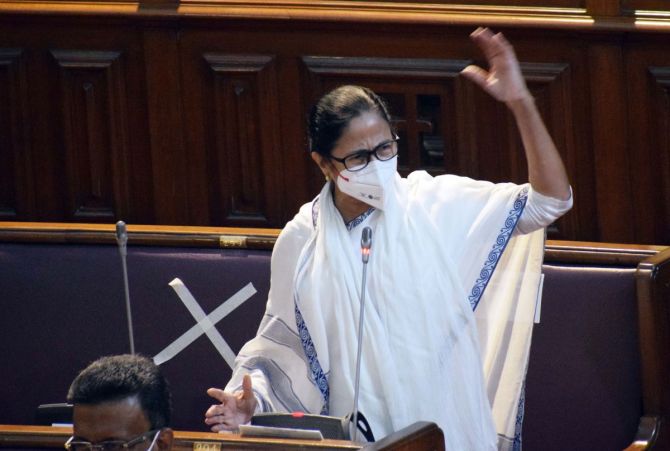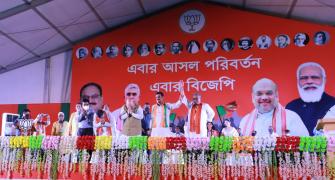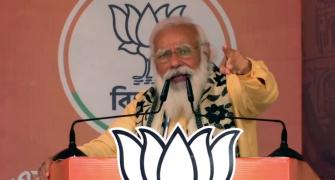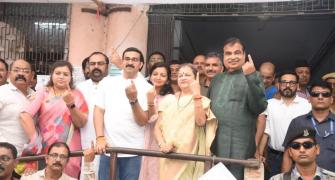The notion that the BJP gained its increased tally by wiping out the Left parties and the Congress is completely misleading.
Equally misleading is the belief that the TMC held its ground in all its existing seats.
A little more than a fifth of the seats Mamata Banerjee's party had won in 2016 was lost to the BJP this time.
A K Bhattacharya explains the Bengal result.

Many explanations and many more implications of the results of the assembly elections in five states are doing the rounds. Each of the outcomes in these states had a unique element, making it politically significant for both national politics and the future of regional parties in India.
It would be instructive to summarise the key trends emerging from these results.
The reigning Left Democratic Front has retained power in Kerala, winning a second consecutive term for the first time in an election that has also resulted in the Bharatiya Janata Party losing its only seat in the state.
The rise of Kerala Chief Minister Pinarayi Vijayan as a strong power centre in Left politics in the southern state is as important as the Left parties' rapidly disappearing footprint in the eastern states of West Bengal and Tripura.
Tamil Nadu saw the Dravida Munnetra Kazhagam reclaim the state from its arch-rival, the All India Anna DMK. Having inherited the leadership of the DMK from his father M Karunanidhi, M K Stalin has now established his firm control over the party with this victory.
In Puducherry, the alliance between the BJP and the All-India NR Congress dethroned the Congress government and re-established the leadership of AINRC chief N Rangaswamy.
In Assam, the BJP retained the state, though with a reduced majority. The Congress, on the other hand, improved its performance in Assam, but only by 13 seats, not enough to have a majority and form the government.
Of the five states that went into polls this year, West Bengal stayed ahead of the rest by commanding most of the attention of political analysts and observers.
Here was a state in which the Mamata Banerjee-led Trinamool Congress was striving hard to secure victory for the third time running and that too against a massive pre-poll Hindutva-dominated campaign launched by the BJP's top leadership.
In the end, the TMC improved its seats tally to retain its two-thirds majority in the assembly. The BJP improved its tally from 3 to 77, which in itself was an impressive performance, but it fell short of the goal of dethroning the TMC in Bengal.
An important development that deserves to be underlined here is that the election results show the Congress in poor light. Its ability to win elections looks seriously undermined. It lost Puducherry and failed to reclaim two other states.
Worse, the Congress and the Left parties now have no representation in the West Bengal assembly for the first time since Independence.
A widely held belief from the final results in West Bengal is that the BJP has cornered the seats that were earlier held by the Left parties and the Congress. Such a belief has been fuelled by the final tally: The Congress and the Left parties had won 76 seats in 2016 and lost all of them in 2021, while the BJP's tally went up from 3 in 2016 to 77 in 2021, while TMC increased its seats from 211 in 2016 to 213 in 2021 (with elections for two more seats to be held later).
But a seat-wise analysis of results provided by the Election Commission reveals a different story. The BJP's rise from 3 to 77 seats was achieved by the party winning as many as 48 seats that the TMC had held in 2016. The saffron party wrested only 15 from the Congress and 9 from the Left parties and the remaining came from the Gorkha Janmukti Morcha (2) and anIindependent. It retained only two of the three seats it had won in 2016, and it lost the remaining seat to the TMC.
The notion that the BJP gained its increased tally by wiping out the Left parties and the Congress is, therefore, completely misleading.
Equally misleading is the belief that the TMC held its ground in all its existing seats. A little more than a fifth of the seats Mamata Banerjee's party had won in 2016 was lost to the BJP this time.
It compensated this huge loss by expanding its footprint in seats that were earlier held by the Congress and the Left parties.
Of the new seats the TMC won in 2021, as many as 29 came after defeating the Congress and 22 seats were gained by edging out the Left parties.
Just as the BJP gained by taking away the TMC seats, the TMC more than made good its loss by vanquishing the Congress and the Left parties.
Another interesting outcome trend pertains to the BJP's performance in different phases of the West Bengal elections.
Of the 8 phases of polling in the state, the BJP won about 31 per cent of the 180 seats in the fray in the first five phases of polling. But in the final three phases of polling, when Covid restrictions and infections were on the rise, the BJP's strike rate fell to 21 per cent of the 112 seats that were contested.
Conversely, the TMC's share in seats for the last three phases was over 81 per cent, much more than the 68 per cent in the first five phases.
Those who believed that Covid or the Election Commission's decision to stagger the elections over eight phases did not have an impact on the poll result should think again.
The question for TMC in the next five years would be how well it can protect its own turf against the inroads that the BJP has already made.
The battle in 2026 will be squarely between the TMC and the BJP. The outcome of that battle will largely depend on how well the TMC can deliver a better and more people-friendly governance model in the next five years.
In the last five years, the TMC government did well by rolling out several welfare schemes, including those that benefitted the girl child, women and the rural poor.
Even without using central schemes like the Ayushman Bharat (health insurance) and Kisan Samman (cash transfer for farmers), West Bengal figured among the top states using funds under several other central schemes like the Mahatma Gandhi National Rural Employment Guarantee Programme, rural housing scheme, rural road construction programme and the scheme for concessional distribution of cooking gas cylinders.
It is reasonable to believe that the TMC's electoral success in 2021 was to a great extent facilitated by the successful rollout of these welfare schemes, funded by the state government as also by the Centre.
If the TMC government in its third term can improve its governance model, reduce corruption in delivery of its schemes for the poor and take full advantage of all the central welfare schemes, Banerjee may not have to just use the Bengali exceptionalism card.
Instead, with the help of such welfare schemes and better governance, she could put up a stronger fight.











